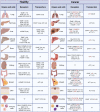Glutamatergic system components as potential biomarkers and therapeutic targets in cancer in non-neural organs
- PMID: 36457557
- PMCID: PMC9705578
- DOI: 10.3389/fendo.2022.1029210
Glutamatergic system components as potential biomarkers and therapeutic targets in cancer in non-neural organs
Abstract
Glutamate is one of the most abundant amino acids in the blood. Besides its role as a neurotransmitter in the brain, it is a key substrate in several metabolic pathways and a primary messenger that acts through its receptors outside the central nervous system (CNS). The two main types of glutamate receptors, ionotropic and metabotropic, are well characterized in CNS and have been recently analyzed for their roles in non-neural organs. Glutamate receptor expression may be particularly important for tumor growth in organs with high concentrations of glutamate and might also influence the propensity of such tumors to set metastases in glutamate-rich organs, such as the liver. The study of glutamate transporters has also acquired relevance in the physiology and pathologies outside the CNS, especially in the field of cancer research. In this review, we address the recent findings about the expression of glutamatergic system components, such as receptors and transporters, their role in the physiology and pathology of cancer in non-neural organs, and their possible use as biomarkers and therapeutic targets.
Keywords: cancer; excitatory amino acid transporter (EAAT); glutamate/cystine antiporter (xCT); ionotropic glutamate receptor (iGluR); metabotropic glutamate receptor (mGluR); non-neural organs.
Copyright © 2022 García-Gaytán, Hernández-Abrego, Díaz-Muñoz and Méndez.
Conflict of interest statement
The authors declare that the research was conducted in the absence of any commercial or financial relationships that could be construed as a potential conflict of interest.
Figures




Similar articles
-
Glutamatergic Signaling in the Central Nervous System: Ionotropic and Metabotropic Receptors in Concert.Neuron. 2018 Jun 27;98(6):1080-1098. doi: 10.1016/j.neuron.2018.05.018. Neuron. 2018. PMID: 29953871 Free PMC article. Review.
-
Glutamate receptors in pediatric tumors of the central nervous system.Cancer Biol Ther. 2010 Mar 15;9(6):455-68. doi: 10.4161/cbt.9.6.10898. Epub 2010 Mar 9. Cancer Biol Ther. 2010. PMID: 20061814
-
Main path and byways: non-vesicular glutamate release by system xc(-) as an important modifier of glutamatergic neurotransmission.J Neurochem. 2015 Dec;135(6):1062-79. doi: 10.1111/jnc.13348. Epub 2015 Sep 29. J Neurochem. 2015. PMID: 26336934 Free PMC article. Review.
-
Ionotropic and metabotropic glutamate receptor structure and pharmacology.Psychopharmacology (Berl). 2005 Apr;179(1):4-29. doi: 10.1007/s00213-005-2200-z. Epub 2005 Feb 25. Psychopharmacology (Berl). 2005. PMID: 15731895 Review.
-
Modulatory effects of Ampicillin/Sulbactam on glial glutamate transporters and metabotropic glutamate receptor 1 as well as reinstatement to cocaine-seeking behavior.Behav Brain Res. 2017 Aug 14;332:288-298. doi: 10.1016/j.bbr.2017.06.017. Epub 2017 Jun 15. Behav Brain Res. 2017. PMID: 28624317 Free PMC article.
Cited by
-
A glutamatergic biomarker panel enables differentiating Grade 4 gliomas/astrocytomas from brain metastases.Front Oncol. 2024 May 21;14:1335401. doi: 10.3389/fonc.2024.1335401. eCollection 2024. Front Oncol. 2024. PMID: 38835368 Free PMC article.
-
Whole-genome bisulfite sequencing identifies stage- and subtype-specific DNA methylation signatures in pancreatic cancer.iScience. 2024 Mar 4;27(4):109414. doi: 10.1016/j.isci.2024.109414. eCollection 2024 Apr 19. iScience. 2024. PMID: 38532888 Free PMC article.
-
Bench-to-Bedside Studies of Arginine Deprivation in Cancer.Molecules. 2023 Feb 24;28(5):2150. doi: 10.3390/molecules28052150. Molecules. 2023. PMID: 36903394 Free PMC article. Review.
-
NMDA Receptor and Its Emerging Role in Cancer.Int J Mol Sci. 2023 Jan 28;24(3):2540. doi: 10.3390/ijms24032540. Int J Mol Sci. 2023. PMID: 36768862 Free PMC article. Review.
-
Comparison of transcriptome profiles of radiotherapy beams on MCF-7 breast cancer xenografts.Breast Cancer. 2025 Jun 27. doi: 10.1007/s12282-025-01735-1. Online ahead of print. Breast Cancer. 2025. PMID: 40579643
References
Publication types
MeSH terms
Substances
LinkOut - more resources
Full Text Sources
Medical

